Toomas Hendrik Ilves
Toomas Hendrik Ilves (Estonian pronunciation: [ˈtoːmɑs ˈhendrik ˈilves]; born 26 December 1953) is the fourth and current President of Estonia. He is a former diplomat and journalist, was the leader of the Social Democratic Party in the 1990s and later a member of the European Parliament. He was elected to the post by an electoral college on 23 September 2006 and his term as President began on 9 October 2006.
Childhood and education
Ilves was born in Stockholm, Sweden; his parents were Estonian refugees.[1] He grew up in the United States and graduated from Leonia High School in Leonia, New Jersey in 1972 as valedictorian.[2] He received a bachelor's degree in psychology from Columbia University and a master's degree in the same subject from the University of Pennsylvania.
As a result of his upbringing, Ilves speaks English with an American accent.
Career
During the 1980s, Ilves worked as a journalist for Radio Free Europe and became actively involved in politics prior to Estonia's independence in 1991. Ilves subsequently became Ambassador of Estonia to the United States in 1993;[3] he also served as Ambassador to Canada and Mexico for several years.
In December 1996, Ilves became Estonian Minister of Foreign Affairs, serving until he resigned in September 1998, when he became member of a small opposition party (Peasants' Party, agrarian-conservative). Ilves was soon elected chairman of the People's Party (reformed Peasants' Party), which formed an electoral cartel with the Moderates, a centrist party. After the March 1999 parliamentary election he became foreign minister again, serving until 2002, when the so-called Triple Alliance collapsed. He supported Estonian membership in the European Union and succeeded in starting the negotiations which led to Estonia joining the European Union on 1 May 2004. From 2001 to 2002 he was the leader of the People's Party Moderates. He resigned from the position after the party's defeat in the October 2002 municipal elections, in which the party received only 4.4% of the total votes nationwide. In early 2004, the Moderates party renamed itself the Estonian Social Democratic Party.
In 2003, Ilves became an observer member of the European Parliament and, on 1 May 2004, a full member. In the 2004 elections to the European Parliament, Ilves was elected MEP in a landslide victory for the Estonian Social Democratic Party. He sat with the Party of European Socialists group in the Parliament. Katrin Saks took over his MEP seat when Ilves became President of Estonia.
Presidential elections
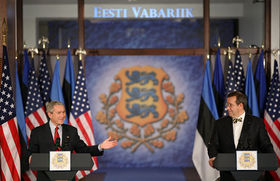
President Toomas Hendrik Ilves and President
George W. Bush, in Estonia 2006
Ilves was nominated by the Reform Party, Union of Pro Patria and Res Publica and his own Social Democratic Party on 23 March 2006, as a candidate for the 2006 presidential election.
On 29 August, Ilves was the only candidate in the second and the third round of the presidential election in Riigikogu, the Parliament of Estonia (he was supported by an electoral coalition consisting of the governing Reform Party plus the Social Democrats and the Union of Pro Patria and Res Publica which form the parliamentary opposition). The elections were boycotted by the Centre Party and the People's Union (the MPs were called upon by the party leaders not to participate in the election). Ilves gathered 64 votes out of 65 ballots. Therefore, one deputy of the three party alliance supporting Ilves did not vote in favour of his candidacy. A two-third majority in the 101-seat Riigikogu was required, so he was not elected in Riigikogu. His candidacy was automatically transferred to the next round in the Electors' Assembly on 23 September.
On 13 September 2006, a broad spectrum of 80 well-known intellectuals published a declaration in support of Ilves' candidacy. Among those who signed were Neeme Järvi, Jaan Kross, Arvo Pärt and Jaan Kaplinski.[4]
On 23 September 2006 he received 174 ballots in the first round of the presidential election in the Electors' Assembly, thus having been elected the next president of Estonia. His five-year term started on 9 October 2006.
Ilves has promised to concentrate more on foreign policy; according to Ilves, "The road to Moscow goes via Brussels." He also wishes to move Estonia politically more towards the centre of Europe. With regard to Estonia's domestic policies, he has supported re-affirming the president's role as a moral arbitrator in case of leading politicians' misdeeds. Ilves has severely criticised alleged political pressure exercised by the Centre Party and People's Union leaders over their parliamentary deputies and local politicians. Edgar Savisaar in turn has expressed dissatisfaction with Ilves' victory.
Personal life
Ilves has been married twice. With his first wife, American psychologist Dr. Merry Bullock he has two children: son Luukas (b. 1987), who graduated from Stanford University in 2009 and is currently attending military service as a conscript in the Estonian army, and daughter Juulia Kristiine (b. 1992). In 2004 Ilves married his long-term partner Evelin Int-Lambot with whom he has one daughter, Kadri Keiu (b. 2003).
In public, Ilves almost exclusively wears bow ties. He says that this is because his late father used to do so.[5]
Ilves has a brother, Andres Ilves, head of the Persian and Pashto World Service of the BBC. Andres graduated from Princeton University in the early 1980s and was awarded a fellowship with the public affairs leadership training program Coro Southern California based in Los Angeles, California. Until the early 2000s, Andres Ilves was head of the Afghanistan bureau of Radio Free Europe/Radio Liberty based in Prague, Czech Republic.
Decorations
- 1999 Knight First Class of the Royal Norwegian Order of Merit.
- 1999 Grand Cross of the Order of Honour of Greece.
- 2001 Commander of the Légion d'Honneur of the Republic of France.
- 2004 Third Class Order of the Seal of the Republic of Estonia.
- 2004 Three Star Order of the Republic of Latvia.
- 2006 The Collar of the Order of the Cross of Terra Mariana (Estonia).
- 2006 The Knight Grand Cross of the Order of the Bath of Great Britain.
- 2007 Order of the White Rose of Finland.
- 2007 The Grand Cordon of the Supreme Order of the Chrysanthemum of Japan.[6]
- 2007 The Golden Fleece Order of Georgia.
- 2007 The Order of Isabella the Catholic with Collar of Spain.
- 2008 The Collar of the Order of the National Coat of Arms (Estonia), also known as the Presidential Chain.
- 2008 The Order of Vytautas the Great with the Golden Chain of Lithuania.
- 2008 The Knight Grand Cross of the Order of the Netherlands Lion.
- 2008 Grand Cordon of the Order of Leopold (Belgium).
- 2009 The Chain of the Order of the Three Stars (Latvia).
- 2009 The Grand Cross of the Order of Merit (Hungary).
- 2010 The Order of St. George of Georgia.
[7]
See also
References
External links
| Political offices |
Preceded by
Siim Kallas |
Minister of Foreign Affairs
1996–1998 |
Succeeded by
Raul Mälk |
Preceded by
Raul Mälk |
Minister of Foreign Affairs
1999–2002 |
Succeeded by
Kristiina Ojuland |
Preceded by
Arnold Rüütel |
President of Estonia
2006–present |
Incumbent |
|
Heads of State of Estonia |
|
Chairman
of the Council of Ministers |
|
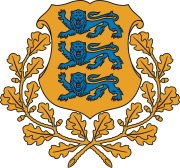
|
|
| Prime Ministers |
Päts (Poska) · Strandman · Tõnisson · Birk · Tõnisson · Piip
|
|
| State Elders |
Piip · Päts · Kukk · Päts · Akel · Jaakson · Teemant · Tõnisson · Rei · Strandman · Päts · Teemant · Einbund · Päts · Tõnisson · Päts
|
|
Prime Minister
in Duties of the State Elder |
|
|
| President-Regent |
|
|
| President |
|
|
Prime Ministers
in Duties of the President |
Uluots · Rei · Warma · Kint · Mark
|
|
| Presidents |
|
|
| Acting Heads of State · 1-Soviet prisoner · 2-Illegally installed by Soviet occupation authorities |
|
|
previous ← Members of the European Parliament 2004–2009 → following |
|
|
Austria MEPs 2004–2009 |
|
|
Maria Berger · Herbert Bösch · Harald Ettl · Othmar Karas · Jörg Leichtfried · Eva Lichtenberger · Hans-Peter Martin · Andreas Mölzer · Christa Prets · Reinhard Rack · Karin Resetarits · Paul Rübig · Karin Scheele · Agnes Schierhuber · Richard Seeber · Ursula Stenzel · Hannes Swoboda · Johannes Voggenhuber
|

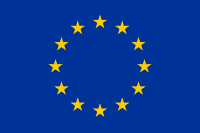 |
|
|
|
|
Belgium MEPs 2004–2009 |
|
|
Dutch electoral college
|
Ivo Belet · Frieda Brepoels (replacing Geert Bourgeois) · Philip Claeys · Jean-Luc Dehaene · Mia De Vits · Koenraad Dillen (replacing Filip Dewinter) · Saïd el Khadraoui · Annemie Neyts-Uyttebroeck · Bart Staes · Dirk Sterckx (replacing Guy Verhofstadt) · Marianne Thyssen · Frank Vanhecke · Johan Van Hecke (replacing Karel De Gucht) · Anne Van Lancker |
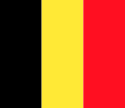
 |
|
|
French electoral college
|
Philippe Busquin (replacing Elio Di Rupo) · Véronique de Keyser · Gérard Deprez · Antoine Duquesne (replacing Louis Michel) · Alain Hutchinson · Pierre Jonckheer · Raymond Langendries (replacing Joëlle Milquet) · Frédérique Ries · Marc Tarabella (replacing Michel Daerden)
|
|
|
German electoral college
|
Mathieu Grosch
|
|
|
|
|
Bulgaria MEPs 2007–2009 |
|
|
Mariela Baeva · Slavcho Binev · Desislav Chukolov · Filiz Husmenova · Rumiana Jeleva · Metin Kazak · Evgeni Kirilov · Marusya Lyubcheva · Nikolay Mladenov · Vladko Panayotov · Atanas Paparizov · Biliana Raeva · Petya Stavreva · Dimitar Stoyanov · Vladimir Uruchev · Kristian Vigenin · Iliana Yotova · Dushana Zdravkova
|

 |
|
|
|
|
Cyprus MEPs 2004–2009 |
|
|
Adamos Adamou · Panayiotis Demetriou · Ioannis Kasoulides · Marios Matsakis · Yiannakis Matsis · Kyriacos Triantaphyllides
|

 |
|
|
|
|
Czech Republic MEPs 2004–2009 |
|
|
Jana Bobošíková · Jan Březina · Milan Cabrnoch · Petr Duchoň · Hynek Fajmon · Richard Falbr · Věra Flasarová · Jana Hybášková · Jaromír Kohlíček · Jiří Maštálka · Miroslav Ouzký · Miloslav Ransdorf · Vladimír Remek · Zuzana Roithová · Libor Rouček · Nina Škottová · Ivo Strejček · Daniel Stroz · Oldřich Vlasák · Jan Zahradil · Tomáš Zatloukal · Vladimír Železný · Jozef Zieleniec · Jaroslav Zvěřina
|
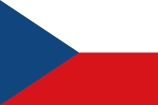
 |
|
|
|
|
Denmark MEPs 2004–2009 |
|
Margrete Auken · Hanne Dahl · Niels Busk · Mogens Camre · Ole Christensen · Anne Elisabet Jensen · Dan Jørgensen · Søren Søndergaard · Christel Schaldemose · Poul Nyrup Rasmussen · Karin Riis-Jørgensen · Johannes Lebech · Gitte Seeberg · Britta Thomsen |
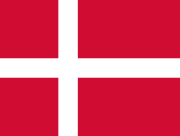
 |
|
|
|
|
Estonia MEPs 2004–2009 |
|
|
Toomas Hendrik Ilves (replaced by Katrin Saks) · Tunne Kelam · Marianne Mikko · Siiri Oviir · Toomas Savi · Andres Tarand
|
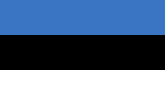
 |
|
|
|
|
Finland MEPs 2004–2009 |
|
|
Satu Hassi · Ville Itälä · Anneli Jäätteenmäki · Piia-Noora Kauppi · Eija-Riitta Korhola · Henrik Lax · Lasse Lehtinen · Riitta Myller · Reino Paasilinna · Sirpa Pietikäinen · Esko Seppänen · Hannu Takkula · Paavo Väyrynen · Kyösti Virrankoski
|
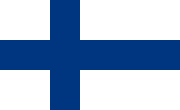
 |
|
|
|
|
France MEPs 2004–2009 |
|
|
East France
|
Jean Marie Beaupuy · Catherine Boursier · Bruno Gollnisch · Natalie Griesbeck · Benoît Hamon · Marie-Anne Isler-Béguin · Véronique Mathieu · Pierre Pribetich · Catherine Trautmann
|

 |
|
|
Île-de-France
|
Pervenche Berès · Paul-Marie Coûteaux · Harlem Désir · Anne Ferreira · Nicole Fontaine · Patrick Gaubert · Marine Le Pen · Bernard Lehideux · Alain Lipietz · Marielle de Sarnez · Gilles Savary · Pierre Schapira · Jacques Toubon · Francis Wurtz
|
|
|
Massif Central-Centre
|
Jean-Pierre Audy · Jean-Paul Denanot · Marie-Hélène Descamps · Janelly Fourtou · Catherine Guy-Quint · Brice Hortefeux · André Laignel
|
|
|
North-West France
|
Jean-Louis Cottigny · Brigitte Douay · Hélène Flautre · Brigitte Fouré · Jean-Paul Gauzès · Jacky Henin · Carl Lang · Fernand Le Rachinel · Marie-Noëlle Lienemann · Vincent Peillon · Tokia Saïfi
|
|
|
Overseas Territories
|
Catherine Néris · Margie Sudre · Paul Verges
|
|
|
South-East France
|
Jean-Luc Bennahmias · Guy Bono · Marie-Arlette Carlotti · Thierry Cornillet · Claire Gibault · Françoise Grossetête · Jean-Marie Le Pen · Patrick Louis · Michel Rocard · Martine Roure · Lydia Schenardi · Ari Vatanen · Dominique Vlasto |
|
|
South-West France
|
Kader Arif · Françoise Castex · Jean-Marie Cavada · Alain Lamassoure · Anne Laperrouze · Jean-Claude Martinez · Gérard Onesta · Béatrice Patrie · Christine de Veyrac · Michel Teychenné
|
|
|
West France
|
Marie-Hélène Aubert · Ambroise Guellec · Stéphane Le Foll · Roselyne Lefrançois · Philippe Morillon · Élisabeth Morin-Chartier · Yannick Vaugrenard · Bernadette Vergnaud · Philippe de Villiers
|
|
|
|
|
Germany MEPs 2004–2009 |
|
Alexander Nuno Alvaro · Angelika Beer · Rolf Berend · Reimer Böge · Hiltrud Breyer · André Brie · Elmar Brok · Udo Bullmann · Daniel Caspary · Jorgo Chatzimarkakis · Daniel Cohn-Bendit · Michael Cramer · Albert Dess · Garrelt Duin · Christian Ehler · Markus Ferber · Karl-Heinz Florenz · Ingo Friedrich · Michael Gahler · Evelyne Gebhardt · Norbert Glante · Lutz Goepel · Alfred Gomolka · Friedrich-Wilhelm Graefe zu Baringdorf · Ingeborg Grässle · Lissy Gröner · Matthias Groote · Klaus Hänsch · Rebecca Harms · Jutta Haug · Ruth Hieronymi · Karsten Friedrich Hoppenstedt · Milan Horáček · Georg Jarzembowski · Elisabeth Jeggle · Karin Jöns · Gisela Kallenbach · Sylvia-Yvonne Kaufmann · Heinz Kindermann · Ewa Klamt · Christa Klaß · Wolf Klinz · Dieter-Lebrecht Koch · Silvana Koch-Mehrin · Christoph Werner Konrad · Holger Krahmer · Konstanze Krehl · Wolfgang Kreissl-Doerfler · Helmut Kuhne · Alexander Graf Lambsdorff · Werner Langen · Armin Laschet · Kurt Joachim Lauk · Kurt Lechner · Klaus-Heiner Lehne · Jo Leinen · Peter Liese · Erika Mann · Thomas Mann · Helmuth Markov · Hans-Peter Mayer · Hartmut Nassauer · Angelika Niebler · Vural Öger · Cem Özdemir · Doris Pack · Tobias Pflüger · Willi Piecyk · Markus Pieper · Hans-Gert Poettering · Bernd Posselt · Godelieve Quisthoudt-Rowohl · Alexander Radwan · Bernhard Rapkay · Herbert Reul · Dagmar Roth-Behrendt · Mechtild Rothe · Heide Rühle · Frithjof Schmidt · Ingo Schmitt · Horst Schnellhardt · Juergen Schröder · Elisabeth Schroedter · Martin Schulz · Willem Schuth · Andreas Schwab · Renate Sommer · Ulrich Stockmann · Helga Trüpel · Feleknas Uca · Thomas Ulmer · Karl von Wogau · Sahra Wagenknecht · Ralf Walter · Manfred Weber · Barbara Weiler · Anja Weisgerber · Reiner Wieland · Joachim Wuermeling · Gabi Zimmer |

 |
|
|
|
|
Greece MEPs 2004–2009 |
|
|
Stavros Arnaoutakis · Katerina Batzeli · Panagiotis Beglitis · Giorgos Dimitrakopoulos · Georgios Karatzaferis (replaced by Georgios Georgiou) · Ioannis Gklavakis · Konstantinos Hatzidakis · Rodi Kratsa-Tsagaropoulou · Stavros Lambrinidis · Diamanto Manolakou · Maria Matsouka · Manolis Mavrommatis · Thanasis Pafilis · Marie Panayotopoulos-Cassiotou · Dimitrios Papadimoulis · Georgios Papastamkos · Antonis Samaras · Nikolaos Sifounakis · Giorgos Toussas · Antonios Trakatellis · Evangelia Tzampazi · Nikos Vakalis · Ioannis Varvitsiotis · Marilisa Xenogiannakopoulou
|
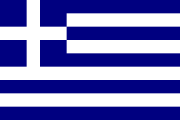
 |
|
|
|
|
Hungary MEPs 2004–2009 |
|
|
Etelka Barsiné Pataky · Zsolt László Becsey · Antonio De Blasio · Alexandra Dobolyi · Szabolcs Fazakas · Kinga Gál · Béla Glattfelder · Zita Gurmai · András Gyürk · Gábor Harangozó · Gyula Hegyi · Edit Herczog · Lívia Járóka · Magda Kósáné Kovács · Katalin Lévai · Viktória Mohácsi · Péter Olajos · Csaba Őry · Pál Schmitt · György Schöpflin · László Surján · József Szájer · István Szent-Iványi · Csaba Sándor Tabajdi
|

 |
|
|
|
|
Ireland MEPs 2004–2009 |
|
|
Dublin
|
Proinsias De Rossa · Mary Lou McDonald · Gay Mitchell · Eoin Ryan
|
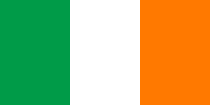
 |
|
|
East
|
Liam Aylward · Avril Doyle · Mairead McGuinness
|
|
|
North-West
|
Marian Harkin · Jim Higgins · Seán Ó Neachtain
|
|
|
South
|
Simon Coveney (replaced by Colm Burke) · Brian Crowley · Kathy Sinnott
|
|
|
|
|
Italy MEPs 2004–2009 |
|
|
Central
|
Roberta Angelilli · Alfredo Antoniozzi · Alessandro Battilocchio · Carlo Casini · Alessandro Foglietta · Lilli Gruber · Umberto Guidoni · Luisa Morgantini · Alessandra Mussolini · Pasqualina Napoletano · Lapo Pistelli · Guido Sacconi · Luciana Sbarbati · Antonio Tajani · Stefano Zappalà · Nicola Zingaretti |
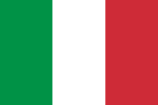
 |
|
|
Islands
|
Giuseppe Castiglione · Giusto Catania · Luigi Cocilovo · Claudio Fava · Raffaele Lombardo · Nello Musumeci · Francesco Musotto
|
|
|
North East
|
Sergio Berlato · Giovanni Berlinguer · Umberto Bossi · Iles Braghetto · Renato Brunetta · Marco Cappato · Giorgio Carollo · Paolo Costa · Michl Ebner · Gian Paolo Gobbo · Donata Gottardi · Sepp Kusstatscher · Roberto Musacchio · Vittorio Prodi · Amalia Sartori · Mauro Zani |
|
|
North West
|
Vittorio Agnoletto · Gabriele Albertini · Vito Bonsignore · Mario Borghezio · Giulietto Chiesa · Carlo Fatuzzo · Francesco Ferrari · Monica Frassoni · Jas Gawronski · Romano Maria la Russa · Pia Elda Locatelli · Mario Mantovani · Mario Mauro · Cristiana Muscardini · Marco Pannella · Pier Antonio Panzeri · Guido Podestà · Marco Rizzo · Giovanni Rivera · Francesco Speroni · Gianluca Susta · Patrizia Toia |
|
|
Southern
|
Vincenzo Aita · Alfonso Andria · Gianni De Michelis · Giuseppe Gargani · Vincenzo Lavarra · Andrea Losco · Achille Occhetto · Aldo Patriciello · Umberto Pirilli · Giovanni Pittella · Adriana Poli Bortone · Luca Romagnoli · Salvatore Tatarella · Riccardo Ventre · Armando Veneto · Donato Tommaso Veraldi · Marcello Vernola
|
|
|
|
|
Latvia MEPs 2004–2009 |
|
Georgs Andrejevs · Valdis Dombrovskis · Guntars Krasts · Ģirts Valdis Kristovskis · Aldis Kušķis · Rihards Pīks · Inese Vaidere · Tatjana Ždanoka · Roberts Zīle |
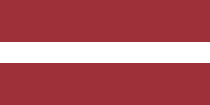
 |
|
|
|
|
Lithuania MEPs 2004–2009 |
|
Laima Liucija Andrikienė · Šarūnas Birutis · Danutė Budreikaitė · Arūnas Degutis · Jolanta Dičkutė · Gintaras Didžiokas · Eugenijus Gentvilas · Ona Juknevičienė · Vytautas Landsbergis · Justas Vincas Paleckis · Rolandas Pavilionis · Aloyzas Sakalas · Margarita Starkevičiūtė |
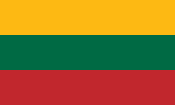
 |
|
|
|
|
Luxembourg MEPs 2004–2009 |
|
|
Robert Goebbels · Erna Hennicot-Schoepges · Astrid Lulling · Lydie Polfer · Jean Spautz · Claude Turmes
|
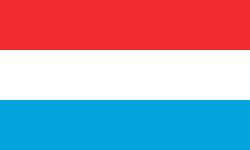
 |
|
|
|
|
Malta MEPs 2004–2009 |
|
|
John Attard Montalto · Glenn Bedingfield · Simon Busuttil · David Casa · Louis Grech · Joseph Muscat
|
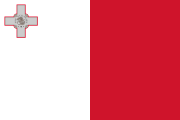
 |
|
|
|
|
Netherlands MEPs 2004–2009 |
|
|
Bert Doorn · Camiel Eurlings · Esther de Lange · Albert-Jan Maat · Maria Martens · Lambert van Nistelrooij · Ria Oomen-Ruijten · Joop Post · Cornelis Visser · Corien Wortmann-Kool · Max van den Berg · Thijs Berman · Emine Bozkurt · Ieke van den Burg · Jan Cremers · Dorette Corbey · Lily Jacobs · Edith Mastenbroek · Jan-Marinus Wiersma · Jeanine Hennis-Plasschaert · Jules Maaten · Toine Manders · Jan Mulder · Kathalijne Buitenweg · Joost Lagendijk · Paul van Buitenen · Els de Groen · Kartika Liotard · Erik Meijer · Johannes Blokland · Bastiaan Belder · Sophie in 't Veld
|
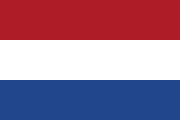
 |
|
|
|
|
Poland MEPs 2004–2009 |
|
Filip Adwent · Adam Bielan · Jerzy Buzek · Zdzisław Chmielewski · Sylwester Chruszcz · Marek Czarnecki · Ryszard Czarnecki · Hanna Foltyn-Kubicka · Bronisław Geremek · Lidia Geringer de Oedenberg · Adam Gierek · Maciej Giertych · Bogdan Golik · Genowefa Grabowska · Dariusz Grabowski · Małgorzata Handzlik · Stanisław Jałowiecki · Mieczysław Janowski · Filip Kaczmarek · Michał Kamiński · Bogdan Klich · Urszula Krupa · Wiesław Kuc · Barbara Kudrycka · Jan Kułakowski · Zbigniew Kuźmiuk · Janusz Lewandowski · Bogusław Liberadzki · Marcin Libicki · Jan Masiel · Jan Olbrycht · Janusz Onyszkiewicz · Bogdan Pęk · Józef Pinior · Mirosław Piotrowski · Paweł Piskorski · Zdzisław Podkański · Jacek Protasiewicz · Bogusław Rogalski · Dariusz Rosati · Wojciech Roszkowski · Leopold Rutowicz · Jacek Saryusz-Wolski · Czesław Siekierski · Marek Siwiec · Bogusław Sonik · Grażyna Staniszewska · Andrzej Szejna · Konrad Szymański · Witold Tomczak · Janusz Wojciechowski · Bernard Piotr Wojciechowski · Zbigniew Zaleski · Andrzej Tomasz Zapałowski · Tadeusz Zwiefka |

 |
|
|
|
|
Portugal MEPs 2004–2009 |
|
|
Francisco Assis · Luis Manuel Capoulas Santos · Paulo Casaca · Carlos Coelho · Fausto Correia · Manuel António dos Santos · Maria da Assunção Esteves · Edite Estrela · Emanuel Jardim Fernandes · Elisa Ferreira · Ilda Figueiredo · Duarte Freitas · Ana Maria Gomes · Vasco Graça Moura · Pedro Guerreiro · Jamila Madeira · Sérgio Marques · João de Deus Pinheiro · Miguel Portas · Luís Queiró · José Ribeiro e Castro · José Albino Silva Peneda · Sérgio Sousa Pinto
|
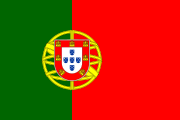
 |
|
|
|
|
Romania MEPs 2007–2009 |
|
|
Roberta Alma Anastase · Sebastian Valentin Bodu · Victor Boştinaru · Nicodim Bulzesc · Cristian Buşoi · Titus Corlăţean · Corina Creţu · Gabriela Creţu · Csaba Sógor · Magor Csibi · Dragoş Florin David · Daniel Dăianu · Constantin Dumitru · Sorin Frunzăverde · Petru Filip · Monica Maria Iacob Ridzi · Marian-Jean Marinescu · Ramona Mănescu · Cătălin Ioan Nechifor · Rareş Lucian Niculescu · Dumitru Oprea · Ioan Mircea Paşcu · Maria Petre · Rovana Plumb · Mihaela Popa · Nicolae-Vlad Popa · Daciana Octavia Sârbu · Adrian Severin · Theodor Stolojan · László Tőkés · Silvia Adriana Ţicău · Adina Ioana Vălean · Renate Weber · Iuliu Winkler · Marian Zlotea
|
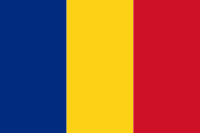
 |
|
|
|
|
Slovakia MEPs 2004–2009 |
|
|
Peter Baco · Edit Bauer · Irena Belohorská · Monika Beňová · Árpád Duka-Zólyomi · Milan Gaľa · Ján Hudacký · Miloš Koterec · Sergej Kozlík · Vladimír Maňka · Miroslav Mikolášik · Zita Pleštinská · Peter Šťastný · Anna Záborská
|
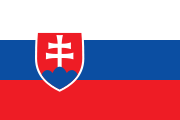
 |
|
|
|
|
Slovenia MEPs 2004–2009 |
|
|
Mihael Brejc · Mojca Drčar Murko · Romana Jordan Cizelj · Jelko Kacin · Ljudmila Novak · Borut Pahor (replaced by Aurelio Juri) · Lojze Peterle
|
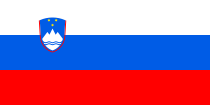
 |
|
|
|
|
Spain MEPs 2004–2009 |
|
|
Inés Ayala Sender · María del Pilar Ayuso González · María Badía i Cutchet · Enrique Barón Crespo · Josep Borrell Fontelles · Joan Calabuig Rull · Carlos Carnero González · Alejandro Cercas Alonso · Luis de Grandes Pascual · Pilar del Castillo Vera · Agustín Díaz de Mera García Consuegra · Rosa Díez González · Bárbara Dührkop Dührkop · Fernando Fernández Martín · Carmen Fraga Estévez · Gerardo Galeote Quecedo · José García-Margallo y Marfil · Iratxe García Pérez · Salvador Garriga Polledo · Ignasi Guardans Cambó · Cristina Gutiérrez-Cortines · David Hammerstein Mintz · María Esther Herranz García · Luis Herrero-Tejedor Algar · Carlos José Iturgáiz Angulo · Mikel Irujo · Antonio López-Istúriz White · Miguel Angel Martínez Martínez · Antonio Masip Hidalgo · Ana Mato Adrover · Jaime María Mayor Oreja · Manuel Medina Ortega · Íñigo Méndez de Vigo · Emilio Menéndez del Valle · Willy Meyer Pleite · Rosa Miguélez Ramos · Francisco José Millán Mon · Cristóbal Montoro Romero · Javier Moreno Sánchez · Raimon Obiols i Germà · Josu Ortuondo Larrea · Francisca Pleguezuelos Aguilar · José Javier Pomés Ruiz · Teresa Riera Madurell · Raül Romeva Rueda · Luisa Fernanda Rudi Ubeda · José Salafranca Sánchez-Neira · María Isabel Salinas García · Antolín Sánchez Presedo · María Sornosa Martínez · María Elena Valenciano Martínez-Orozco · Daniel Varela Suanzes-Carpegna · Alejo Vidal-Quadras Roca · Luis Yañez-Barnuevo García
|
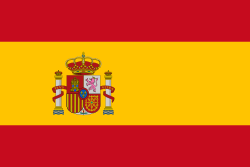
 |
|
|
|
|
Sweden MEPs 2004–2009 |
|
|
Jan Andersson · Maria Carlshamre · Charlotte Cederschiöld · Lena Ek · Christofer Fjellner · Hélène Goudin · Anna Hedh · Ewa Hedkvist Petersen · Gunnar Hökmark · Anna Ibrisagic · Nils Lundgren · Cecilia Malmström · Carl Schlyter · Inger Segelström · Jonas Sjöstedt · Eva-Britt Svensson · Åsa Westlund · Anders Wijkman · Lars Wohlin
|
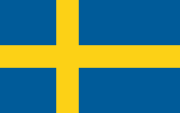
 |
|
|
|
|
United Kingdom MEPs 2004–2009 |
|
|
East Midlands
|
Derek Clark · Chris Heaton-Harris · Roger Helmer · Robert Kilroy-Silk · Bill Newton Dunn · Phillip Whitehead (replaced by Glenis Willmott)
|
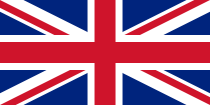
 |
|
|
East of England
|
Christopher Beazley · Andrew Duff · Richard Howitt · Robert Sturdy · Jeffrey Titford · Geoffrey van Orden · Tom Wise
|
|
|
London
|
Gerard Batten · John Bowis · Robert Evans · Mary Honeyball · Jean Lambert · Sarah Ludford · Claude Moraes · Charles Tannock · Theresa Villiers (replaced by Syed Kamall)
|
|
|
North East England
|
Martin Callanan · Fiona Hall · Stephen Hughes
|
|
|
North West England
|
Robert Atkins · Chris Davies · Den Dover · Saj Karim · Arlene McCarthy · David Sumberg · Gary Titley · John Whittaker · Terry Wynn (replaced by Brian Simpson)
|
|
|
Northern Ireland
|
Jim Allister · Bairbre de Brún · Jim Nicholson
|
|
|
Scotland
|
Elspeth Attwooll · Ian Hudghton · David Martin · John Purvis · Alyn Smith · Struan Stevenson · Catherine Stihler
|
|
|
South East England
|
Richard Ashworth · Chris Huhne (replaced by Sharon Bowles) · Nirj Deva · James Elles · Nigel Farage · Daniel Hannan · Caroline Lucas · Ashley Mote · Emma Nicholson · Peter Skinner |
|
|
South West England
|
Giles Chichester · Trevor Colman · Glyn Ford · Caroline Jackson · Roger Knapman · Neil Parish · Graham Watson
|
|
|
Wales
|
Jillian Evans · Jonathan Evans · Glenys Kinnock · Eluned Morgan
|
|
|
West Midlands
|
Philip Bradbourn · Philip Bushill-Matthews · Michael Cashman · Neena Gill · Malcolm Harbour · Liz Lynne · Mike Nattrass
|
|
|
Yorkshire & the Humber
|
Godfrey Bloom · Richard Corbett · Timothy Kirkhope · Linda McAvan · Edward McMillan-Scott · Diana Wallis
|
|
|
|
|
|
| Category · European Union |
|
| Persondata |
| Name |
Ilves, Toomas Hendrik |
| Alternative names |
|
| Short description |
Estonian president |
| Date of birth |
26 December 1953 |
| Place of birth |
Stockholm, Sweden |
| Date of death |
living |
| Place of death |
|



